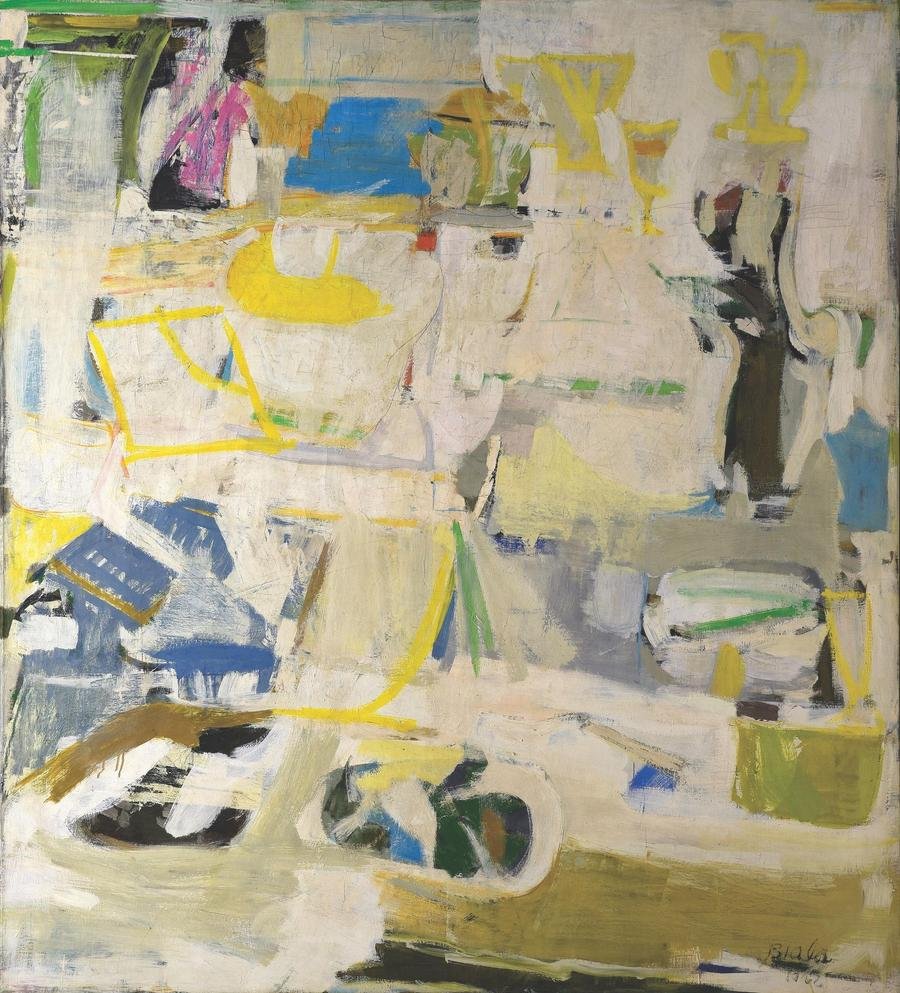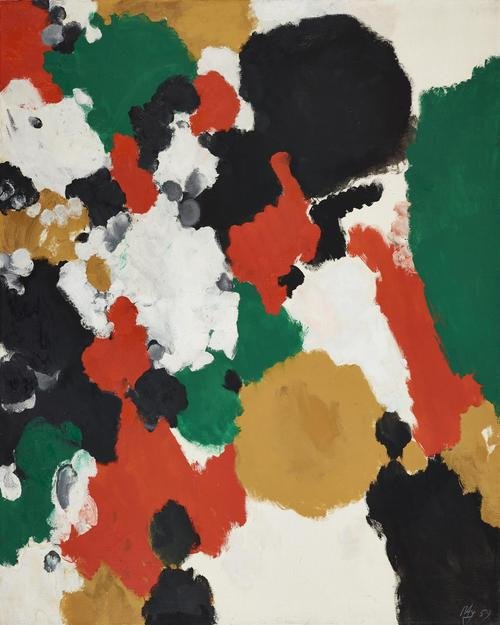Exhibition News (via Artful Daily): The Shape of Freedom: International Abstraction After 1945
The exhibition focuses on the two most important currents of abstraction following World War II: Abstract Expressionism in the United States and Art Informel in western Europe.
Janice Biala, Untitled (Still Life with Three Glasses), 1962. Oil and collage on canvas, 162,6 x 145,4 cm. Collection Richard and Karen Duffy, Chicago. © VG Bild-Kunst, Bonn 2022 Image: McCormick Gallery, Chicago
Jackson Pollock, Composition No. 16, 1948. Oil on canvas 56,5 × 39,5 cm. Museum Frieder Burda, Baden-Baden © Pollock-Krasner Foundation / VG Bild-Kunst, Bonn 2022
The role of the artist, of course, has always been that of image-maker. Different times require different images. ... To my mind certain so-called abstraction is not abstraction at all. On the contrary, it is the realism of our time. - Adolph Gottlieb, 1947
The Shape of Freedom: International Abstraction after 1945 is a major new traveling exhibition debuting at the Museum Barberini, in Potsdam, Germany, on June 4, 2022.
The exhibition focuses on the two most important currents of abstraction following World War II: Abstract Expressionism in the United States and Art Informel in western Europe. The Shape of Freedom is the first exhibition to explore this transatlantic dialogue in art from the mid-1940s to the end of the Cold War.
The show comprises around 100 works by over 50 artists including Sam Francis, Helen Frankenthaler, K. O. Götz, Georges Mathieu, Lee Krasner, Ernst Wilhelm Nay, Mark Rothko, Jackson Pollock, Judit Reigl, and Clyfford Still. Works on loan come from over 30 international museums and private collections including the Kunstpalast Düsseldorf, the Tate Modern in London, the Museo nacional Thyssen-Bornemisza in Madrid, the Metropolitan Museum of Art and the Whitney Museum of American Art in New York, the Centre Pompidou in Paris, the Peggy Guggenheim Collection in Venice, and the National Gallery of Art in Washington, DC.
After its opening run in Potsdam, a version of the exhibition will travel to the Albertina modern in Vienna (opening October 15, 2022) and then the Munchmuseet in Oslo.
Ortrud Westheider, Director of the Museum Barberini, Potsdam, said, “The paintings in the exhibition bear witness to the tremendous longing for artistic freedom that emerged on both sides of the Atlantic after 1945. The Hasso Plattner Collection, with important works by Norman Bluhm, Joan Mitchell, and Sam Francis, served as our point of departure. The concept developed by our curator Daniel Zamani was so convincing that the Albertina modern in Vienna and the Munchmuseet in Oslo agreed to host the exhibition as well. I am delighted to see this European cooperation.”
World War II was a turning point in the development of modern painting. The presence of exiled European avant-garde artists in America transformed New York into a center of modernism that rivaled Paris and set new artistic standards. In the mid-1940s, a young generation of artists in both the United States and Europe turned their back on the dominant stylistic directions of the interwar years. Instead of figurative painting or geometric abstraction they embraced a gestural, expressive handling of form, color, and material—a radically experimental approach that transcended traditional conceptions of painting. Artists like Jackson Pollock, Lee Krasner, Willem de Kooning, Franz Kline, Hans Hofmann, and Joan Mitchell discovered an intersubjective form of expression in action painting, while the color field painting of Mark Rothko, Barnett Newman, Adolph Gottlieb, Robert Motherwell, and Clyfford Still presented viewers with an overwhelming visual experience.
Virtual Event (Jan 6): Biala: The Rash Acts of Rescue and Escape
Biala (1903-2000) “June Femme,” c.1933, Oil on panel, 25 1/2 x 21 1/4 in (66 x 55.9 cm) Collection of the Estate of Janice Biala © Estate of Janice Biala / Artists Rights Society (ARS), New York
January 6, 2021 @ 12:00 pm - 1:00 pm | Free
Lecture by
Jason Andrew, Independent Scholar, Curator and Producer in New York
with
Julia Gleich, Choreographer
Introduced by
Rachel Stern, Executive Director of the Fritz Ascher Society in New York
Biala (1903-2000) was a Polish born American painter whose career stretched over eight decades and spanned two continents. Through it all, she retained an intimacy in her art rooted in Old World Europe—sensibilities that began with memories of her childhood in a Polish village, shaped by School of Paris painters like Bonnard, Matisse and Braque, inspired by Velázquez and the Spanish Masters, and broadened by the community of loft-living artists in Post World War II Downtown New York.
Her arrival in Paris in 1930 from New York City marked the beginning of an extraordinary transatlantic life: one full of adventure, a passion for literature, and an appetite for art. On that fateful trip she met and fell in love with the English Novelist Ford Madox Ford. Ford shared with her all he knew and introduced her to the many artists forging a new Modernism including Brancusi, Matisse, Picasso, and Gertrude Stein among others. Biala became Ford’s most fierce advocate remaining devoted to him, at his side, until his death in Deauville, France on June 26, 1939.
Biala’s commitment to Ford did not soften at his death. In this lecture, Jason Andrew shares his research and insight into Biala’s harrowing effort to traveled back to the South of France, which was in Mussolini’s cross-hairs, to make the daring rescue of Ford’s manuscripts and library, just as war would consume all of Europe. Joining Andrew in this presentation is choreographer Julia K. Gleich, who will bring voice to the letters of Janice Biala.
Jason Andrew
is an independent scholar, curator, and producer. He is the founding partner at Artist Estate Studio LLC, the entity that represents the estates of Jack Tworkov, Janice Biala, and Elizabeth Murray among others. He has written, lectured, and curated extensively on the life and art of Janice Biala and her contemporaries including a retrospective of the artist’s work at Provincetown Art Association and Museum in 2018, as an exhibition focused on Biala’s work 1952-1962 on view at McCormick Gallery, Chicago through January 2021.
Julia K Gleich
is a choreographer, teacher, scholar and mathematics aficionado with an MA from the Bolz Center for Arts Administration at the University of Wisconsin-Madison and an MFA from the University of Utah. In 2004, Julia Gleich, in partnership with Jason Andrew, founded Norte Maar for Collaborative Projects in the Arts with a mission to renew and refresh the exchange within the interdisciplinary arts. She then became a partner in Artist Estate Studio, LLC. Ms. Gleich is the founder and Artistic Director of Gleich Dances, which has received critical notice in The New York Times, DanceInforma, DanceInsider, Village Voice, The New Criterion, The Brooklyn Rail, among others.
The event is part of the monthly series: Flight or Fight. stories of artists under repression, which is generously sponsored by Allianz Partners. Future events and the recordings of past events can be found HERE.









